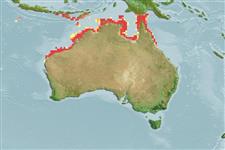>
Eupercaria/misc (Various families in series Eupercaria) >
Haemulidae (Grunts) > Plectorhinchinae
Etymology: Plectorhinchus: Greek, plektos = plaited + Greek, rhyngchos = snout (Ref. 45335); caeruleonothus: Name from the Latin words 'caeruleo' for blue and 'nothus' for bastard when combined as ‘Blue Bastard’ which has been commonly applied to this species by anglers for many years; referring to its blue sheen in life and difficulty to hook and land on artificial fly..
Environment: milieu / climate zone / depth range / distribution range
بوم شناسي
دريايي وابسته به آب سنگ; تغييرات عمق 6 - 30 m (Ref. 103290). Tropical; 9°S - 25°S, 101°E - 147°E (Ref. 103290)
Southwest Pacific: Australia (Western Australia toi Queensland).
Size / Weight / سن
Maturity: Lm ? range ? - ? cm
Max length : 100.0 cm TL جنس نر / بدون خواص جنسي; (Ref. 103290)
توصيف مختصر
ريخت شناسي | ريخت ستجي بوسيله انداره گيري
خارهاي باله پشتي (کل): 12; شعاع نرم باله پشتي (کل): 18-20; خارهاي باله مخرجي 3; شعاع نرم باله مخرجي: 6 - 7. This species is distinguished by the following features: D XII, 18-20 (rarely 20); A III, 6-7 (rarely III, 6); pectoral-fin rays 16-17 (usually 17); lateral-line scales 56-61 (modally 59); transverse scale rows above lateral line 15; gill rakers 7-9 + 18-20 = 25-29 (modally 26); in juveniles, pelvic fins reaching anus, slightly short of anus in adults; nostrils minute, 0.4-0.8 % SL, 2-3 times in distance from posterior nostril to eye; when fresh colouration in adults with body uniformly silver-grey, cheek and opercles blue-grey, rim of orbit and dorsal edge of maxilla dusky yellow, posterior margin of opercular membrane silver-grey, non-contrasting with remainder of opercle and adjacent body (Ref. 103290).
This species is found on sand, rubble and reef bottom but mostly in the intertidal zone, or shallow reef; one specimen trawled in a depth of 30 m. The most southerly record is a large individual estimated to be 100 cm in total length. Large individuals are most often solitary, foraging diurnally over relatively open expanses of soft substrate. Agonistic behavioural interactions have been recorded between individuals, individuals have often been observed to interact highly aggressively, engaging in one-on-one conflicts (Ref. 103290).
Life cycle and mating behavior
بلوغ | تولید مثل | تخم ریزی | تخم ها | Fecundity | توزاد ( لارو)
Johnson, J.W. and J.W. Wilmer, 2015. Plectorhinchus caeruleonothus, a new species of sweetlips (Perciformes: Haemulidae) from northern Australia and the resurrection of P. unicolor (Macleay, 1883), a species previously confused with P. schotaf (Forsskål, 1775). Zootaxa 3985(4):491-522. (Ref. 103290)
وضعيت در فهرست قرمز IUCN (Ref. 130435)
خطر برای انسان ها
Harmless
استفاده انسانی
اطلاعات بيشتر
اسامي عاممترادفسوخت و سازشکارچیانسم شناسي بوم زيستيتولید مثلبلوغتخم ریزیSpawning aggregationFecundityتخم هانمو تخم
Age/Sizeرشدطول - وزنطول - طولنوسانات طولیريخت ستجي بوسيله انداره گيريريخت شناسيتوزاد ( لارو)پويايي لارويبازسازیفراوانيBRUVS
مراجعآبزي پرورينمايه آبزي پرورينژادهاژنتيكElectrophoresesوارثبيماري هافرآوریNutrientsMass conversion
همكارانعکس هاStamps, Coins Misc.صداهاسيگواتراسرعتنوع شناگریمنطقه آبششيOtolithsمغزهابینایی
ابزارها
گزارش های ويژه
بارگيری XML
منابع اينترنتي
Estimates based on models
Phylogenetic diversity index (Ref.
82804): PD
50 = 0.5000 [Uniqueness, from 0.5 = low to 2.0 = high].
Bayesian length-weight: a=0.01380 (0.00670 - 0.02842), b=3.00 (2.83 - 3.17), in cm total length, based on LWR estimates for this Genus-body shape (Ref.
93245).
Trophic level (Ref.
69278): 3.9 ±0.6 se; based on size and trophs of closest relatives
جهندگی (Ref.
120179): خیلی آهسته, كمينه زمان لازم براي دو برابر شدن جمعيت بيش از 14 سال (Preliminary K or Fecundity.).
Fishing Vulnerability (Ref.
59153): High vulnerability (60 of 100).
Nutrients (Ref.
124155): Calcium = 21.8 [8.7, 40.3] mg/100g; Iron = 0.445 [0.233, 0.856] mg/100g; Protein = 19.4 [17.5, 21.3] %; Omega3 = 0.106 [0.058, 0.178] g/100g; Selenium = 36.5 [20.4, 62.3] μg/100g; VitaminA = 57.3 [21.5, 147.8] μg/100g; Zinc = 0.964 [0.681, 1.396] mg/100g (wet weight);
